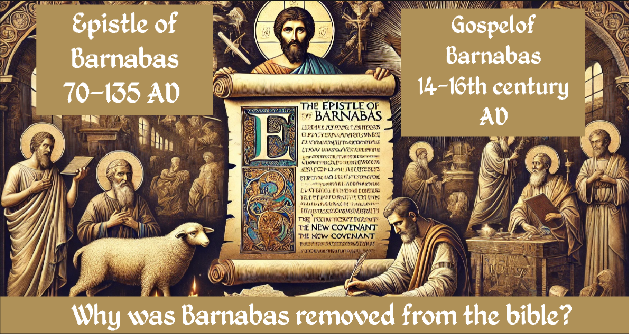For centuries, The Epistle of Barnabas, not to be confused with the much later forgery the Gospel of Barnabas, was considered an important Christian text, included in early canon lists and even bound in some Bibles. But today, it’s relegated to the shadows as an apocryphal work. So why was it once part of Christian scripture, and why was it ultimately cast aside?
Epistle vs Gospel
Timeline & Authorship
| Feature | Epistle of Barnabas | Gospel of Barnabas |
|---|---|---|
| When Written | 70–135 AD (Early Christian period) | 14th–16th century AD (Medieval period) |
| Language | Greek (original) | Italian and Spanish (no Greek or Latin versions exist) |
| Authorship | Unknown, but falsely attributed to Barnabas (Paul’s companion) | Also falsely attributed to Barnabas, but likely written by a medieval author |
| Early Christian Use | Read by some churches, included in Codex Sinaiticus, but later rejected from canon | No evidence of its existence before medieval times, making it a clear forgery |
Message & Key Teachings
| Feature | Epistle of Barnabas | Gospel of Barnabas |
|---|---|---|
| Main Theme | Allegorical reading of Jewish law; rejection of Jewish customs in favor of Christianity | Denies Jesus’ divinity, presents him as a prophet, and claims Judas was crucified instead |
| View of Jesus | Jesus is the Messiah and Son of God who fulfills Old Testament prophecies | Jesus is not divine, but a human prophet of God, aligning with Islamic theology |
| View of Judaism | Heavily anti-Jewish, claims the Jews misunderstood God’s covenant | No strong anti-Jewish message, but denies core Christian beliefs |
| Theological Influence | Early Christian theology, shaping views on Old Testament interpretation | Islamic influence, as it foretells Muhammad as the next prophet |
| Resurrection | Jesus died and was resurrected, fulfilling prophecy | Jesus was never crucified, contradicting all early Christian accounts |
Historical Authenticity
| Feature | Epistle of Barnabas | Gospel of Barnabas |
|---|---|---|
| Historical Evidence | Quoted by early Church Fathers like Clement and Origen | No references in early Christianity, first appears in the medieval period |
| Canonical Status | Considered important in some early Christian circles, but later rejected | Never considered part of the canon, dismissed as a forgery |
| Why Rejected? | Not written by Barnabas, too allegorical, and its anti-Jewish stance was problematic | Anachronisms, medieval themes, and contradicts all early Christian writings |
The Story of the Epistle of Barnabas
The Epistle of Barnabas presents itself as a letter to Christians, guiding them away from Jewish traditions and towards a true understanding of God’s will. The author—who is falsely attributed to Barnabas, the companion of Paul—argues that the Old Testament was never meant to be taken literally by the Jews. Instead, he insists that Jewish laws were symbolic messages pointing to Jesus Christ, whom the Jews failed to recognize as the Messiah. Because of this, he claims that the Jewish people have been rejected by God, and Christians are now the true heirs of the covenant.

Throughout the letter, the author reinterprets Jewish laws in an allegorical way. For example, he claims that circumcision was never about the flesh but was meant to symbolize a “circumcision of the heart”—a spiritual transformation in Christ. Similarly, the dietary laws were not about food but about avoiding sinful behaviors. The epistle also promotes a dualistic worldview, where humanity is faced with two paths: the Way of Light (Christianity) and the Way of Darkness (Judaism and sin). By choosing Christianity, believers are following the true divine path revealed by Christ.
The Epistle of Barnabas was highly influential in early Christianity and was even considered for inclusion in the Bible. However, it was later excluded from the canon due to its lack of apostolic authorship, heavy use of allegory, and harsh stance against Judaism. While it did not make it into the official New Testament, it was preserved and copied by early Christians, reflecting the tensions between Christianity and Judaism in the 1st and 2nd centuries. Today, it is studied as a key document that shaped early Christian theology and identity, particularly in its effort to separate Christianity from its Jewish roots.
Canonical Contender: Why Was the Epistle of Barnabas Included?
The Epistle of Barnabas was widely respected in early Christianity and was included in major early canon lists, such as the Codex Sinaiticus (4th century AD). Early church leaders valued it because:
- It defended Christianity against Judaism, fitting the growing anti-Jewish sentiment in the early church.
- It emphasized allegorical interpretation, aligning with the way many early Christians read the Old Testament.
- It contained moral teachings that reinforced Christian ethics.
But while it was popular, it wasn’t written by the biblical Barnabas, Paul’s companion. That alone made it questionable as scripture.
How Early Was the Epistle of Barnabas Written?
Some argue Barnabas was written as early as 70-90 AD, making it one of the earliest Christian texts outside the New Testament. Others push it later, into the 2nd century, because it references ideas that became prominent only after the destruction of the Temple in 70 AD.
Allegorical Interpretation: The Hidden Messages in Scripture
A core idea in Barnabas is allegory—the belief that the Old Testament’s laws and events have hidden Christian meanings. It claims:
- The Old Testament was never meant for the Jews—it was actually about Christ all along.
- Jewish laws (circumcision, dietary restrictions, sacrifices) were symbolic teachings, not literal commands.
- God’s true message was only revealed through Jesus and the Christian interpretation of scripture.
This allegorical approach directly contradicted Jewish traditions, making Barnabas an aggressive attack on Judaism.
What Doctrine Does the Epistle of Barnabas Support?
The Epistle of Barnabas promotes ideas that were influential in early Christianity:
- Anti-Jewish Theology – It argues that Jews misunderstood their own scriptures and that God had abandoned them in favor of Christians.
- Moral Dualism – It presents a “Two Ways” doctrine: the way of light (righteousness) and the way of darkness (sin).
- Salvation by Faith, Not Law – It rejects the idea that following Jewish law leads to salvation, aligning with Paul’s teachings.
Where the Epistle of Barnabas Contradicts the Gospels
The Epistle of Barnabas takes positions that clash with the four Gospels:
- Jesus’ Sacrifice as Pre-Planned: It claims Jesus’ death was foreshadowed in Jewish law, while the Gospels present it as a real-time fulfillment of prophecy.
- The Covenant Was Never Jewish: The Gospels acknowledge the Old Covenant with Israel, but Barnabas insists the Jews were never truly God’s chosen people—a radical claim.
- Hostility to Jewish Law: While Jesus says He came to fulfill the Law (Matthew 5:17), Barnabas argues that the Law was never meant to be followed literally.
These contradictions made it less compatible with mainstream Christian doctrine.
Why Was the Epistle of Barnabas Cast as Apocrypha?
By the 4th century, when the official New Testament was being finalized, Barnabas was pushed out because:
- It contradicted Gospel teachings and leaned too heavily into allegory.
- It was too hostile toward Judaism, making it theologically problematic as Christianity sought to define itself.
Eventually, it was labeled apocryphal, surviving as a fascinating relic of early Christian thought.
“Among the disputed writings, which are nevertheless recognized by many, are the so-called Epistle of James and that of Jude, also the second epistle of Peter, and those that are called the Epistles of John, the third and first of which are considered genuine. The Book of Revelation is also disputed… And among the spurious must be reckoned the Acts of Paul, and the so-called Shepherd, and the Apocalypse of Peter, and in addition to these the Epistle of Barnabas, and what are called the Teachings of the Apostles.”
– Eusebius (c. 324 AD) – Church History 3.25
A Glimpse Into Early Christian Conflict
The Epistle of Barnabas is a forgotten voice of early Christianity, revealing a time when the church was still debating Jewish law, scriptural interpretation, and Jesus’ true mission. Though it never made the final cut, its influence can still be felt in the development of Christian theology.
Would Christianity look different today if Barnabas had been included in the Bible? Perhaps—but its exclusion shows just how selective the early church was in shaping the faith we know today.

